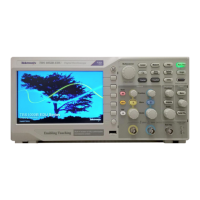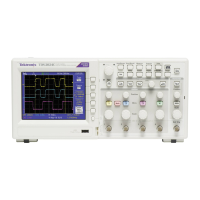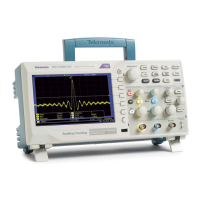Examples
SAVE:WAVEFORM CH1,REF1 saves the CH1 waveform in reference memory
location 1.
:SAVE:WAVEFORM:FILEFORMAT SPREADSHEET; :SAVE:WAVEFORM
Ch1, "usb0/test1_ch1.csv" saves channel 1 waveforms to usb0/test1_ch1.csv.
:SAVe:WAVEform:FILEFormat INTERNal; :SAVe:WAVEform Ch1, "usb0/
test1_ch1.isf" saves channel 1 waveforms usb0/test1_ch1.isf
SAVe:WAVEform:FILEFormat
Specifies or queries the file format for saved waveforms. Waveform header and
timing information is included in the resulting file of non-internal formats.
Group
Save and Recall
Syntax
SAVe:WAVEform:FILEFormat {INTERNal|SPREADSheet}
SAVe:WAVEform:FILEFormat?
Related commands
CURVe on page 87, DATa on page 89, DATa:STARt on page 92, DATa:STOP on
page 93, SAVe:WAVEform on page 210, WFMInpre:NR_Pt? on page 251,
WFMInpre:NR_Pt? on page 251
Arguments
INTERNal specifies that waveforms are saved in an internal format, using aisf
filename extension. These files can be recalled as reference waveforms.
SPREADSheet specifies that waveform data is saved in a format that contains
comma delimited values. These waveform data files are named using the csv
filename extension. Saving waveforms in CSV format enables spreadsheet
programs to import the data.
Examples
SAVE:WAVEFORM:FILEFORMAT INTERNAL specifies that the internal file
format is the format used for saving waveforms.
SAVE:WAVEFORM:FILEFORMAT? might
return :SAVE:WAVEFORM:FILEFORMAT INTERNAL indicating that
waveforms are saved using the internal format.
S commands
TBS2000 Series Programmer 211

